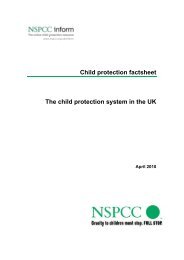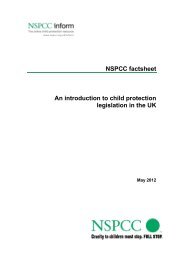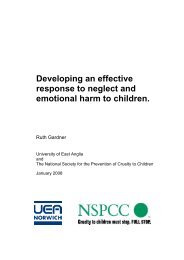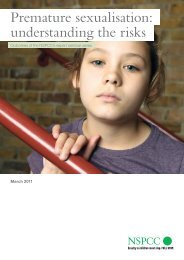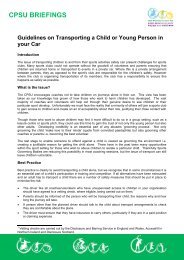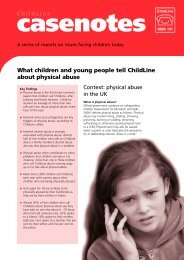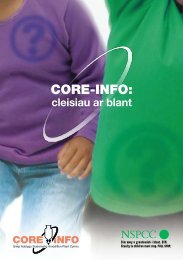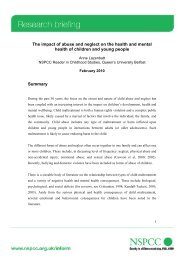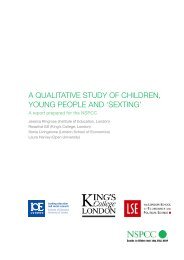Neglect and serious case reviews (PDF, 735KB) - nspcc
Neglect and serious case reviews (PDF, 735KB) - nspcc
Neglect and serious case reviews (PDF, 735KB) - nspcc
You also want an ePaper? Increase the reach of your titles
YUMPU automatically turns print PDFs into web optimized ePapers that Google loves.
<strong>Neglect</strong> <strong>and</strong> Serious Case Reviews<br />
56<br />
what it was like to be a child in this family:<br />
agency involvement:<br />
learning:<br />
The mother’s capacity to care for the children had decreased with each new<br />
birth, <strong>and</strong> she became increasingly emotionally detached from her children.<br />
Basic needs were poorly met, <strong>and</strong> the children often went hungry, had no<br />
bed linen, <strong>and</strong> hardly any toys. The lack of supervision, the squalor, frequent<br />
house moves <strong>and</strong>, above all, the mother’s alcohol intake must have made<br />
all the children’s lives very bewildering <strong>and</strong> distressing.<br />
Over time a large number of social workers <strong>and</strong> family support workers had<br />
been involved with the family, <strong>and</strong> concerns over the care of the children<br />
had been voiced by health visitors, police, a nursery assistant, a school nurse/<br />
school staff <strong>and</strong> neighbours. Following a domestic violence incident, police<br />
were concerned about the conditions in which the children were living, <strong>and</strong><br />
subsequently a child protection enquiry was initiated <strong>and</strong> a core assessment<br />
undertaken. All the children ultimately became the subject of a plan for<br />
emotional abuse <strong>and</strong> neglect. Initially the mother was noted to be making<br />
an effort to cooperate <strong>and</strong> to attend appointments with social workers,<br />
however her engagement became increasingly sporadic <strong>and</strong> unsatisfactory.<br />
Health appointments for the children were not kept, including for spectacles,<br />
dental care, <strong>and</strong> speech <strong>and</strong> language therapy. These specialist services<br />
responded by closing the <strong>case</strong> instead of treating non-attendance as a<br />
warning sign, triggering greater vigilance.<br />
The oldest two children were at primary school, where repeated absences,<br />
dirty clothing <strong>and</strong> hunger were noted but the information was not always<br />
passed through to children’s social care in a timely manner. Chloe attended<br />
nursery, where health visitor concerns about an injury to the child were<br />
discussed <strong>and</strong> passed on to the mother, but not to children’s services. Chloe<br />
was noted to play happily at nursery, as were her siblings at school, <strong>and</strong> the<br />
clean <strong>and</strong> stimulating play environment provided predictability <strong>and</strong> a respite<br />
from the chaos <strong>and</strong> lack of play facilities at home.<br />
Themes emerging from the <strong>serious</strong> <strong>case</strong> review included:<br />
• drift: At one point, there was no social worker allocated at all<br />
<strong>and</strong> concerns reported by other agencies were not responded to.<br />
Assessments were often not completed <strong>and</strong> there were recording<br />
gaps in the CSC files. There was no sense of urgency regarding this<br />
family even when heightened concerns resulted in a child protection<br />
plan for all the children. Key staff rarely attended core group meetings<br />
<strong>and</strong> tasks were undertaken by a social work assistant rather than




